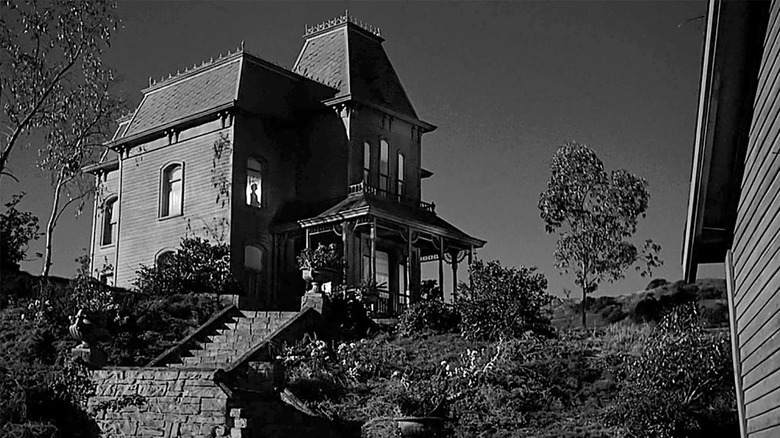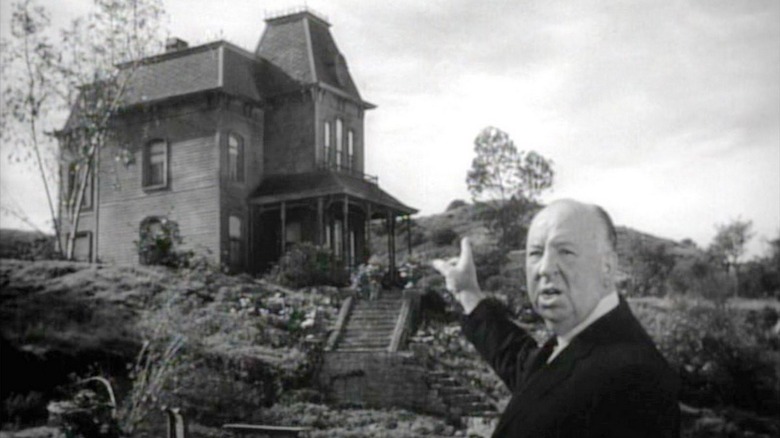Alfred Hitchcock Accidentally Created One Of The Scariest Houses In Horror
Alfred Hitchcock was nothing, if not wholeheartedly sly about his projects. That's especially true when it comes "Psycho."The filmmaker knew that the direction of his twisted horror mystery about an on-the-run secretary and a seemingly innocent motel owner would rattle audiences and catch them off guard when he eventually pulled the rug out from under them. But Hitchcock couldn't have foreseen the legacy that the influential horror film would leave behind. In addition to building upon the foundation of what would become the slasher movie alongside "Peeping Tom" that same year, the popularity of "Psycho" would result in two sequels ("Psycho II" and "Psycho III"), a made-for-TV prequel ("Psycho IV: The Beginning"), a shot-for-shot remake ("Psycho" from 1998), and a contemporary television series that ran for five seasons ("Bates Motel").
However, unless someone has managed to avoid the influence of "Psycho" on pop culture zeitgeist, the magic of discovering the film's big twist is pretty much lost. The pop culture presence of Norman Bates (Anthony Perkins) is as common as Michael Myers or Jason Voorhees. But even with that surprise mostly ruined nowadays, there's a lot in "Psycho" to keep discovering decades later. That's the beauty of watching Hitchcock's work. I admire his ability to grab your attention with such thrilling stories of troubled characters on a surface level, but when you look within, you'll see much more than you initially did. Casual details are established with meaning and purpose, which is why it might surprise you that the creepiness of the "Psycho" house happened almost entirely by accident.
House on Hitchcock's hill
In a stunningly detailed piece from Cinephilia & Beyond, Hitchcock recounts how he came about constructing the now iconic "Psycho" house:
"The mysterious atmosphere is, to some extent, quite accidental. For instance, the actual locale of the events is in northern California, where that type of house is very common. They're either called "California Gothic," or, when they're particularly awful, they're called "California gingerbread." I did not set out to reconstruct an old-fashioned Universal horror picture atmosphere. I simply wanted to be accurate, and there is no question but that both the house and the motel are authentic reproductions of the real thing. I chose that house and motel because I realized that if I had taken an ordinary low bungalow the effect wouldn't have been the same. I felt that type of architecture would help the atmosphere of the yarn."
In addition to Hitchcock's borrowing the "California Gothic" model, there's a famous painting by Edward Hopper called "The House By The Railroad" where you can clearly see the influence it brought to "Psycho." In my eyes, the house operates as an extension of Norman Bates himself. "As if I could do anything but just sit and stare, like one of his stuffed birds," says a disembodied version of Norma Bates that perfectly describes the Bates home just as it applies to Norman. It's perched above the Bates Motel just as the shadow of Norma's corpse looms over Norman. Since these specific types of houses were built so long ago, much like the Bates Motel, the home feels like a haunted relic out of time, which track,s given the only reason the motel has "12 rooms, 12 vacancies" is because the highway veers folks away from it. Marion (Janet Leigh) just had the worst luck when she ended up there.
A real tease
What I found truly interesting about the "Psycho" house was how it was used through its marketing campaign. When the film came out, spoiling the secrets of "Psycho" would be the kind of thing that would likely make Hitchcock resent you from afar. He loved his secrets, so much so that he concocted a massive publicity stunt where theaters were to close the doors once the film had started. "Not even the manager's brother, the President of the United States, or even the Queen of England herself," said the sign that prohibited anyone late to the film from getting into the theater. I can just imagine an underpaid multiplex usher growing some serious contempt for any filmmaker that would dare attempt to pull off something like that today.
If you take a look back at the six-minute theatrical trailer for "Psycho" (seen above), it's a tricky balancing act where Hitchcock gave you a tour of the set as if he were doing so in-universe — including the house. He never quite tells you the grisly events that transpired, as if he's at a loss for words. Upon introducing the set, he walks over to the house describing it as "a little more sinister-looking, less innocent than the motel itself." That really tells you all you need to know. He gives a lot more than you would think for a film with such a strict marketing campaign otherwise. But by the end of his demented little house tour, you knew that something bad happened here and that you won't be forgetting it anytime soon.

